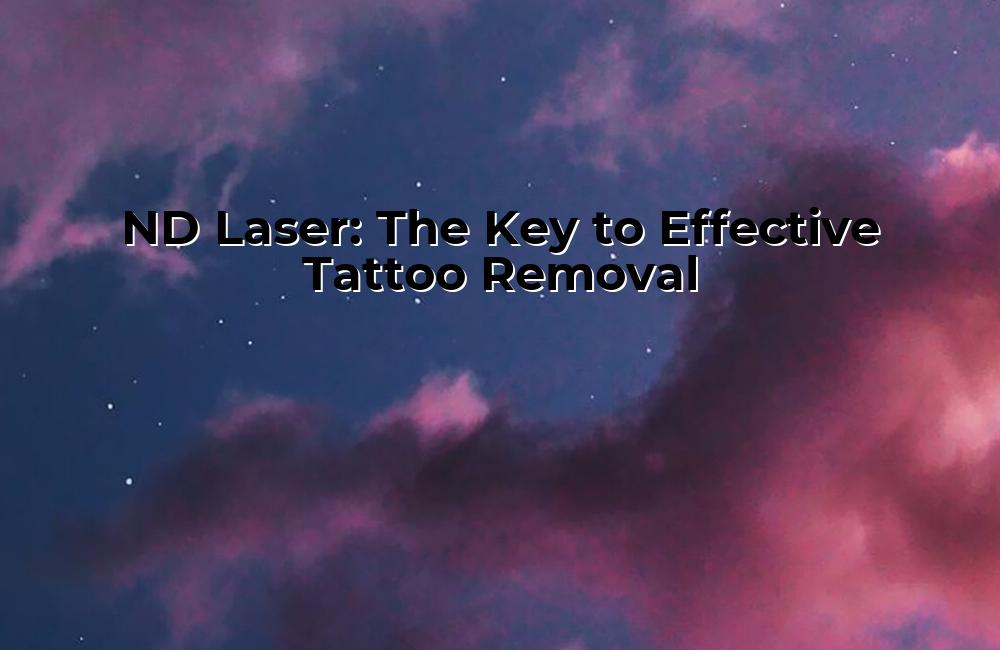ND Laser: The Key to Effective Tattoo Removal
The rising global popularity of cosmetic and corrective tattoos has concurrently led to an increased demand for their removal. While in the past, methods like surgical excision, chemical destruction, and dermabrasion were employed, lasers have emerged as a reliable and effective tool for tattoo removal. Increasing technological options and combination treatment strategies have raised the importance of understanding the various approaches to laser tattoo removal along with their respective clinical impact. This CME aims to describe the multifaceted aspects of laser tattoo removal, including the method selection, application principles, and safety considerations. Furthermore, it addresses the factors considered when selecting the most suitable laser to achieve optimal treatment outcomes.

Tattoo removal is a rapidly growing industry, driven by advancements in laser technology. Among the most popular and effective tools for removing unwanted tattoos is the ND laser, known for its versatility and efficacy in targeting a wide range of tattoo inks. If you are considering tattoo removal or are curious about how the process works, this article will explore why the ND laser is considered the key to effective tattoo removal.
Understanding the ND Laser
The ND (Neodymium-doped Yttrium Aluminum Garnet) laser is a solid-state laser that emits light at two primary wavelengths: 1064 nm and 532 nm. These wavelengths allow the laser to penetrate the skin deeply and break down tattoo pigments into tiny fragments, which the body can then naturally eliminate through the lymphatic system.
- 1064 nm wavelength: This is the most effective for treating darker tattoo inks like black and blue, which are often more difficult to remove.
- 532 nm wavelength: This wavelength is better suited for lighter inks such as red, yellow, and orange.
The versatility of the ND
laser makes it suitable for removing tattoos of varying colors and depths, making it a go-to option for both professionals and patients seeking efficient tattoo removal.
How ND Laser Works
Tattoo removal using the ND laser involves a process called photothermolysis, which means that the laser light selectively targets tattoo ink pigments without damaging the surrounding skin. Here's how the process works:
- Laser Penetration: The laser emits short bursts of high-intensity light that pass through the outer layers of the skin.
- Ink Fragmentation: The energy from the laser is absorbed by the tattoo ink, causing the pigment particles to break into smaller pieces.
- Natural Elimination: Over time, the body’s immune system flushes out these fragmented ink particles through the lymphatic system, gradually fading the tattoo.
Because of its precision, the ND
laser ensures that the surrounding skin tissue remains relatively unaffected, reducing the risk of scarring or other skin complications.
Benefits of ND Laser for Tattoo Removal
1. Minimal Skin Damage
One of the key advantages of the ND laser is that it causes minimal damage to the surrounding skin tissue. The laser selectively targets tattoo pigments, which reduces the likelihood of burns, scars, or pigmentation changes.
2. Effectiveness on Different Tattoo Colors
Tattoo ink comes in a variety of colors, and different pigments absorb laser light at different wavelengths. The dual-wavelength capability of the ND
laser allows it to treat tattoos with both light and dark inks effectively. For darker inks, like black and navy blue, the 1064 nm wavelength is ideal, while for lighter colors like red and orange, the 532 nm wavelength offers optimal results.
3. Safe for Various Skin Types
The ND laser is particularly well-suited for individuals with darker skin tones. Unlike some other laser technologies that can cause hyperpigmentation or hypopigmentation in darker skin, the longer wavelength of the ND laser (1064 nm) penetrates deeper into the skin without affecting the skin's surface, making it safer and less likely to cause discoloration.
4. Fewer Treatment Sessions
Due to its precision and effectiveness, the ND laser often requires fewer sessions to achieve desired results compared to other tattoo removal methods. While the number of sessions will depend on factors such as tattoo size, ink color, and depth, many patients notice significant fading after just a few treatments.
Considerations and Aftercare
While the ND laser is highly effective, it is important to follow proper aftercare instructions to ensure the best results and minimize side effects. After each session, patients are advised to:
- Avoid sun exposure to the treated area for at least two weeks.
- Keep the area clean and moisturized.
- Avoid picking or scratching at any scabs or blisters that may form during healing.
It’s also important to remember that complete tattoo removal may require multiple sessions over several months, depending on the tattoo’s characteristics and individual skin type.
Conclusion
The ND laser has revolutionized the tattoo removal process, offering a safe, efficient, and highly effective solution for eliminating unwanted tattoos. With its ability to target both dark and light inks, minimal damage to surrounding skin, and suitability for various skin types, it stands as one of the leading technologies in the field. If you’re considering tattoo removal, the ND laser offers a reliable and advanced option for achieving the best possible results.
References
Menu
Recommended for you

CIELLULU Q Switch ND YAG Laser for Sale – Ideal for Pigmentation Treatment

How Does Laser Tattoo Removal Work: A Step-by-Step Guide

Expert Tips: What Type of Facial is Best for Acne?

New Laser for White Hair: Revolutionizing Hair Removal
You may also like

CIELLULU Q-Switched ND:YAG Laser LIFFAN Q6
Pigment Removal & Tattoo Removal & Skin Rejuvenation
If you have any comments or good suggestions, please leave us a message. Later, our professional staff will contact you as soon as possible.
Copyright © 2024 CIELLULU Designed by gooeyun. | Privacy Policy • Terms and Conditions








